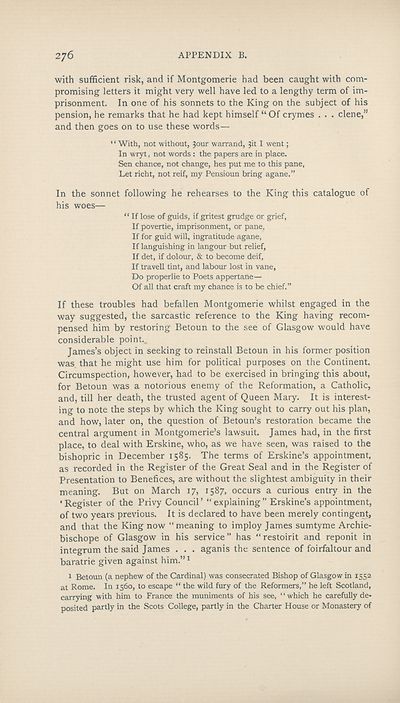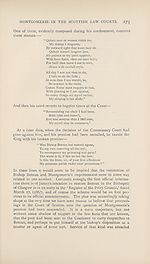Download files
Complete book:
Individual page:
Thumbnail gallery: Grid view | List view

276
APPENDIX B.
with sufficient risk, and if Montgomerie had been caught with com¬
promising letters it might very well have led to a lengthy term of im¬
prisonment. In one of his sonnets to the King on the subject of his
pension, he remarks that he had kept himself “Of crymes . . . clene,”
and then goes on to use these words—
“With, not without, Jour warrand, Jit I went;
In wryt, not words : the papers are in place.
Sen chance, not change, hes put me to this pane,
Let richt, not reif, my Pensioun bring agane.”
In the sonnet following he rehearses to the King this catalogue of
his woes—
“ If lose of guids, if gritest grudge or grief,
If povertie, imprisonment, or pane,
If for guid will, ingratitude agane,
If languishing in langour but relief,
If det, if dolour, & to become deif.
If travell tint, and labour lost in vane,
Do properlie to Poets appertane—
Of all that craft my chance is to be chief.”
If these troubles had befallen Montgomerie whilst engaged in the
way suggested, the sarcastic reference to the King having recom¬
pensed him by restoring Betoun to the see of Glasgow would have
considerable point.
James’s object in seeking to reinstall Betoun in his former position
was that he might use him for political purposes on the Continent.
Circumspection, however, had to be exercised in bringing this about,
for Betoun was a notorious enemy of the Reformation, a Catholic,
and, till her death, the trusted agent of Queen Mary. It is interest¬
ing to note the steps by which the King sought to carry out his plan,
and how, later on, the question of Betoun’s restoration became the
central argument in Montgomerie’s lawsuit. James had, in the first
place, to deal with Erskine, who, as we have seen, was raised to the
bishopric in December 1585. The terms of Erskine’s appointment,
as recorded in the Register of the Great Seal and in the Register of
Presentation to Benefices, are without the slightest ambiguity in their
meaning. But on March 17, 1587, occurs a curious entry in the
‘Register of the Privy Council’ “explaining” Erskine’s appointment,
of two years previous. It is declared to have been merely contingent,
and that the King now “meaning to imploy James sumtyme Archie-
bischope of Glasgow in his service ” has “ restoirit and reponit in
integrum the said James . . . aganis the sentence of foirfaltour and
baratrie given against him.”1
1 Betoun (a nephew of the Cardinal) was consecrated Bishop of Glasgow in 1552
at Rome. In 1560, to escape “ the wild fury of the Reformers,” he left Scotland,
carrying with him to France the muniments of his see, “which he carefully de¬
posited partly in the Scots College, partly in the Charter House or Monastery of
APPENDIX B.
with sufficient risk, and if Montgomerie had been caught with com¬
promising letters it might very well have led to a lengthy term of im¬
prisonment. In one of his sonnets to the King on the subject of his
pension, he remarks that he had kept himself “Of crymes . . . clene,”
and then goes on to use these words—
“With, not without, Jour warrand, Jit I went;
In wryt, not words : the papers are in place.
Sen chance, not change, hes put me to this pane,
Let richt, not reif, my Pensioun bring agane.”
In the sonnet following he rehearses to the King this catalogue of
his woes—
“ If lose of guids, if gritest grudge or grief,
If povertie, imprisonment, or pane,
If for guid will, ingratitude agane,
If languishing in langour but relief,
If det, if dolour, & to become deif.
If travell tint, and labour lost in vane,
Do properlie to Poets appertane—
Of all that craft my chance is to be chief.”
If these troubles had befallen Montgomerie whilst engaged in the
way suggested, the sarcastic reference to the King having recom¬
pensed him by restoring Betoun to the see of Glasgow would have
considerable point.
James’s object in seeking to reinstall Betoun in his former position
was that he might use him for political purposes on the Continent.
Circumspection, however, had to be exercised in bringing this about,
for Betoun was a notorious enemy of the Reformation, a Catholic,
and, till her death, the trusted agent of Queen Mary. It is interest¬
ing to note the steps by which the King sought to carry out his plan,
and how, later on, the question of Betoun’s restoration became the
central argument in Montgomerie’s lawsuit. James had, in the first
place, to deal with Erskine, who, as we have seen, was raised to the
bishopric in December 1585. The terms of Erskine’s appointment,
as recorded in the Register of the Great Seal and in the Register of
Presentation to Benefices, are without the slightest ambiguity in their
meaning. But on March 17, 1587, occurs a curious entry in the
‘Register of the Privy Council’ “explaining” Erskine’s appointment,
of two years previous. It is declared to have been merely contingent,
and that the King now “meaning to imploy James sumtyme Archie-
bischope of Glasgow in his service ” has “ restoirit and reponit in
integrum the said James . . . aganis the sentence of foirfaltour and
baratrie given against him.”1
1 Betoun (a nephew of the Cardinal) was consecrated Bishop of Glasgow in 1552
at Rome. In 1560, to escape “ the wild fury of the Reformers,” he left Scotland,
carrying with him to France the muniments of his see, “which he carefully de¬
posited partly in the Scots College, partly in the Charter House or Monastery of
Set display mode to: Large image | Zoom image | Transcription
Images and transcriptions on this page, including medium image downloads, may be used under the Creative Commons Attribution 4.0 International Licence unless otherwise stated. ![]()
| Publications by Scottish clubs > Scottish Text Society publications > Old series > Poems of Alexander Montgomerie > (357) |
|---|
| Permanent URL | https://digital.nls.uk/110174333 |
|---|
| Description | A collection of over 100 Scottish texts dating from around 1400 to 1700. Most titles are in Scots, and include editions of poetry, drama, and prose by major Scottish writers such as John Barbour, William Dunbar, Gavin Douglas, and George Buchanan. Edited by a key scholarly publisher of Scotland's literary history, and published from the late 19th century onwards by the Scottish Text Society. Available here are STS series 1-3. |
|---|

